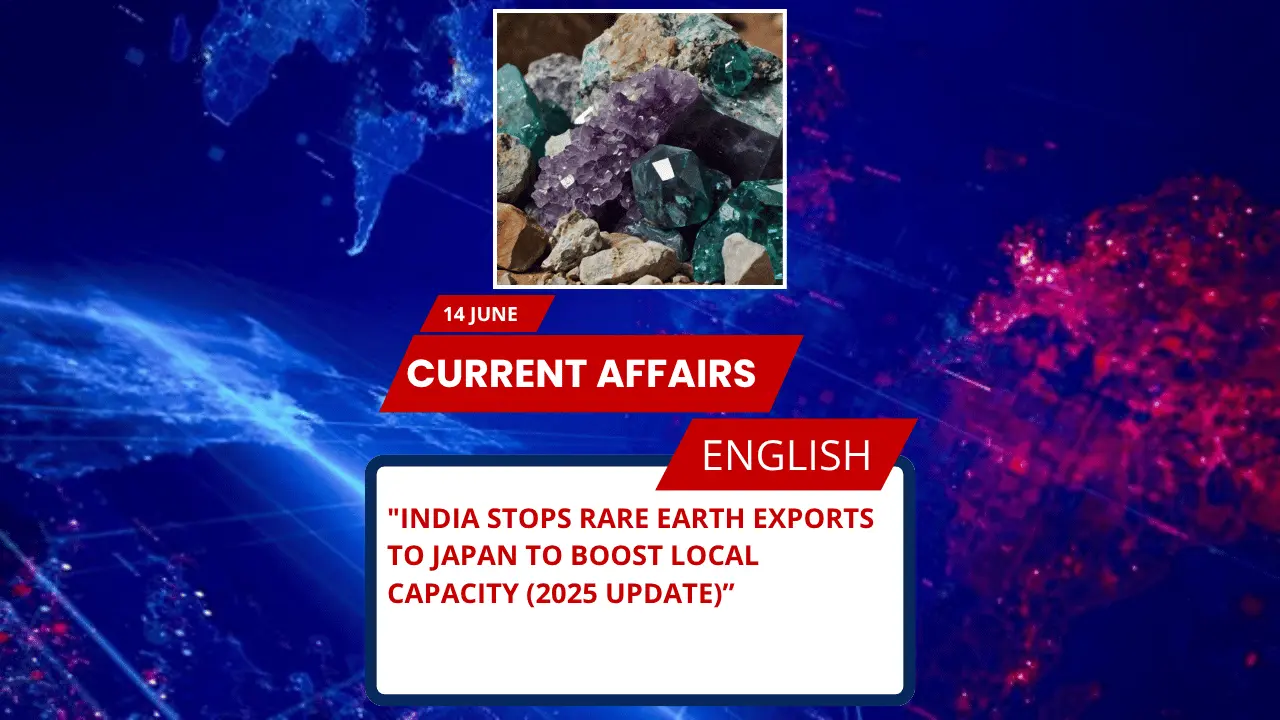
India has suspended its rare earth exports to Japan to strengthen domestic processing and reduce dependence on China amid rising global demand and supply chain concerns.
Key Points for SSC, UPSC, and Other Exams
- India suspended rare earth exports to Japan in 2025 to build domestic capacity.
- The decision affects a 2012 bilateral agreement between IREL (India Rare Earths Limited) and Toyotsu Rare Earths India.
- The export halt comes amid China’s rare earth export restrictions (April 2025).
- India holds the 5th-largest rare earth reserves (~6.9 million metric tons) globally.
- India aims to extract 450 MT of Neodymium by FY 2026 and double production by 2030.
- India imported 53,748 MT of rare earth magnets in FY2024-25, mainly from China.
- Rare earth mining in India is done only by IREL under the Department of Atomic Energy.
Complete Details
India Halts Rare Earth Shipments to Japan – A Strategic Shift
India has paused rare earth exports to Japan by instructing IREL to suspend its 13-year-old supply agreement with Toyotsu Rare Earths India, a subsidiary of Toyota Tsusho. The move comes as China, which controls over 80% of global rare earth processing, tightened its exports in April 2025, impacting global supply chains for electric vehicles, wind turbines, smartphones, and defense systems.
Background of the Agreement
- Year Signed: 2012
- Parties: IREL (India Rare Earths Limited) and Toyotsu Rare Earths India
- Material Focus: Mainly Neodymium (used in EV motors), also Lanthanum and Cerium
- Model: IREL mined rare earths, Toyotsu processed and shipped to Japan
Reason Behind India’s Decision
India aims to:
- Conserve rare earths for domestic use
- Reduce import dependence on China, especially for magnets
- Develop indigenous value-added processing
- Secure supply chains for strategic sectors (EVs, defense)
India’s Rare Earth Sector – Capabilities & Challenges
- Reserves: ~6.9 million metric tons (5th largest globally)
- Mining: Exclusively by IREL, under Department of Atomic Energy
- Processing & Magnet Production: India lacks large-scale facilities; heavily dependent on imports
- FY2024-25 Imports: 53,748 MT rare earth magnets, mostly from China
Expansion Plans
- 450 MT Neodymium extraction target by FY 2026
- Production to double by 2030
- Key sites: Odisha (extraction), Kerala (refining)
- Future: Government incentives for local processing; corporate partnerships for magnet manufacturing
Global Context – Why It Matters
China’s April 2025 restrictions on rare earth exports echo its 2010 embargo on Japan, causing alarm in industries reliant on these materials. India’s move aligns with a global trend of supply chain diversification.
Important Facts About Organizations Mentioned
India Rare Earths Limited (IREL)
- Type: Public sector undertaking
- Under: Department of Atomic Energy, Government of India
- Headquarters: Mumbai, Maharashtra
- Role: Sole authorized miner of rare earths in India
Toyotsu Rare Earths India
- Type: Subsidiary of Toyota Tsusho Corporation, Japan
- Purpose: Rare earth processing in India for exports to Japan
China (context)
- Rare Earth Global Share: >80% processing
- Export Policy: April 2025 export restrictions triggered global supply concerns
MCQs for Practice
1. Which Indian organization is authorized to mine rare earths?
A) NMDC
B) IREL
C) ONGC
D) SAIL
Answer: B) IREL
2. What is the key material in India’s rare earth exports to Japan?
A) Bauxite
B) Neodymium
C) Graphite
D) Copper
Answer: B) Neodymium
3. India holds what global rank in rare earth reserves?
A) 3rd
B) 5th
C) 7th
D) 9th
Answer: B) 5th
4. The agreement to export rare earths to Japan was signed in which year?
A) 2008
B) 2010
C) 2012
D) 2014
Answer: C) 2012
5. Where is IREL’s refining facility located?
A) Odisha
B) Jharkhand
C) Kerala
D) Gujarat
Answer: C) Kerala
UPSC-Style FAQs (Answer Writing Format)
Q1. Why has India halted rare earth exports to Japan in 2025?
Answer:
India halted rare earth exports to Japan in 2025 to prioritize domestic requirements and reduce reliance on China for rare earth magnets and related components. This move came in response to rising global demand, supply chain disruptions due to China’s export restrictions, and India’s strategic goal of developing indigenous processing and manufacturing capabilities in sectors such as electric vehicles, renewable energy, and defense. By doing so, India aims to build a self-reliant rare earth supply chain.
Q2. Discuss India’s rare earth capabilities and challenges in the context of recent policy changes.
Answer:
India has the fifth-largest reserves of rare earth elements globally, with an estimated 6.9 million metric tons. However, its capabilities are limited by the absence of large-scale processing and magnet production facilities, making it heavily dependent on imports, especially from China. The government’s decision to halt exports to Japan reflects efforts to overcome these challenges by conserving resources for domestic industries, developing local processing capacity, and encouraging corporate partnerships. Expansion plans include doubling production by 2030 and setting up incentive schemes for domestic manufacturing.
Q3. How does China’s rare earth policy impact India’s strategic decisions?
Answer:
China’s control over more than 80% of global rare earth processing gives it significant leverage in critical supply chains. The 2025 export restrictions by China have heightened global concerns about supply security, prompting India to reassess its export policies. India’s decision to halt rare earth exports to Japan is directly linked to minimizing dependence on Chinese imports and securing critical inputs for its domestic industries. This strategic shift is also aimed at strengthening India’s position in the global clean energy and defense sectors.







